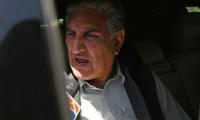One myth that is paraded as a fact is that military rule has always ushered in an era of progress and prosperity for the country. The latest statement of the myth has been put forward by the former military ruler General (r) Pervez Musharraf.
Yes, the economy registered faster growth when the men in uniform held the reins than when a civilian government was in office. Yet – barring Gen Yahya’s short-lived regime – the robust growth rate under each of the three other military rulers was not based on strong fundamentals. Instead, it was fuelled by the generous foreign capital inflows that were pumped into the country as it was a staunch US ally.
As a result, the much-hyped economic progress came to a grinding halt on each occasion when the inflows dried up. To give the lie to the misleading narrative, it would be better to look at the performance of the economy when Pervez Musharraf was the nation’s undisputed master.
At the time of Musharraf’s October 1999 coup, the economy was in dire straits. Pakistan has always counted on external assistance to keep the wheels of the economy moving. But in the wake of the May 1998 decision to go nuclear, Islamabad had been placed under sanctions by the leading donors, including Washington. Those sanctions were shored up as a token of disapproval of upsetting the applecart of democracy.
Not surprisingly, the first two financial years (FY 2000 and FY 2001) of Musharraf’s rule saw the further slowdown of the economy and a downward movement of most of the key economic indicators. In FY 2000, growth decelerated to 3.9 percent from 4.2 percent in 1999 and then slumped to 1.8 percent during FY 2001. Remittances fell from $1.06 billion in FY 1999 to $983 million in FY 2000 before marginally going up to $1.08 billion during FY 2001.
Foreign exchange reserves shrank to $1.96 billion in FY 2000 from $2.27 billion a year earlier and increased to $3.21 billion in FY 2001. FDI registered a modest increase of $94 million that climbed to $470 million in FY 2000. However, it dropped to $322 million next year.
Come 9/11 and the stance taken by Pakistan against the Taliban regime in Afghanistan prompted the West, particularly Washington, to make overtures to Islamabad through debt relief and substantial economic assistance. The US alone gave nearly $12 billion in economic and military assistance to Pakistan. More than any other factor, it was this engagement that ratcheted up the economy.
In FY 2002, the GDP grew by 3.1 percent, which, though modest, was almost double the growth rate during the preceding year. Both remittances and foreign exchange reserves more than doubled to reach $2.39 billion and $6.43 billion, respectively. FDI went up to $485 million. As the trade deficit fell to $1.2 billion, the country recorded a current account surplus of $1.33 billion.
The following year saw further improvement in economic indicators. Growth gained momentum as the economy grew by 4.8 percent. Foreign exchange reserves bulged to $10.72 billion, FDI raked up to $798 million and remittances rose to $4.24 billion. The increased capital inflows improved the rupee-dollar parity to 57.7 from 61 during FY 2002. Trade deficit further fell to $1.06 billion and the current account surplus increased to $3.16 billion.
Between FY 2004 and FY 2008, the economy grew on average by seven percent per annum even though growth fell significantly to 5.8 percent during the last fiscal year. The exchange rate remained relatively stable. However, the second half of FY2008 saw a sharp depreciation of the rupee. Foreign exchange reserves stood at $15.18 billion at the end of FY 2007. Both during FY2007 and FY2008, FDI crossed the$5 billion mark, which was ostensibly an expression of the growing confidence in the economy among foreign investors.
However, other economic indicators underwent a sharp deterioration. Trade deficit skyrocketed from $2.08 billion during FY 1999 to $20.74 billion in FY 2008 and the current account deficit ballooned to $14 billion – seven percent of the GDP – from 4.1 percent in FY 1999. The fiscal deficit rose to seven percent of the GDP while the revenue-GDP ratio fell to 14 percent of the GDP.
External debt reached $56 billion from $37.6 billion in FY 1999 while domestic debt more than doubled to Rs3.14 trillion from Rs1.45 trillion in FY 1999. The enormous increase in domestic debt was mainly attributed to the government’s dependence on bank borrowing as the principal source of deficit financing. The monetisation of fiscal deficit was also a major contributor to inflation, which was 12 percent at the end of FY 2008.
While per capita income increased to $1,085, income disparities also widened. This was evident in the upward movement of the Gini coefficient from 0.27 in FY 2001 to 0.30 during FY 2006. The unemployment rate was six percent for first two years of the Musharraf period. It remained between seven and eight percent for next six years and fell to 5.32 percent during FY 2007.
Although the investment-GDP ratio rose to 22.9 percent in FY 2007 before dropping to 21.6 percent, it did not reflect a healthy growth rate during the Musharraf period. Savings also increased, but not consistently. For instance, in FY 2003, the savings-GDP ratio increased to 20.8 percent but declined to 18.1 percent and 15.1 percent in the next two years.
During FY 2006 and FY 2007, the share of savings in the GDP increased to 16.4 percent and 17.7 percent, respectively, before falling to 13.9 percent in FY2008.
In all, the kernel of Musharraf’s economic policies was the same as that of his predecessor: the deregulation of the economy, a liberal trade and investment regime and the privatisation of state enterprises. However, in some respects, the results were significantly better owing to the relative political stability, which made for the predictability of his policies and a friendly attitude from donors.
The worldwide crackdown on money laundering, which was allegedly used to finance Al-Qaeda activities, meant that workers would increasingly send their remittances through formal banking channels. Those factors contributed to a healthy economic growth, a stable exchange rate and record increases in remittances and FDI.
It is evident that the economic growth during the Musharraf regime was not driven by strong fundamentals. For a developing country like Pakistan, economic growth is a major macroeconomic objective. But growth has to be stable otherwise it will be difficult to sustain. Stable growth entails an appropriate increase in the level of savings and investment, price stability, a high level of employment and stability in the balance of payment (BoP) and financial account positions in addition to the expansion of GDP. However, during the period under review, those key indicators on the whole exhibited a sharp downward trend.
As the bubble of economic growth began to burst during last few months of the Musharraf period, it exposed the essential flaws in the regime’s economic policies. The sustained growth rate is the effect rather than the cause of the enhanced productive capacity of the economy. Therefore, attention needs to be paid towards shoring up the productivity of the factors of production.
However, during the Musharraf period, little was done to increase the productive capacity of the economy and efforts were largely directed towards showing an increase in economic numbers, such as GDP growth and per capita income . The regime also did not put its shoulders to the wheel in addressing critical issues such as the power shortage and a narrow tax base.
Faced with serious macroeconomic imbalances, the PPP government, which took office in May 2008, was forced to go to the IMF within six months of its inauguration.
The economic management by military regimes on the one hand and civilian governments on the other has not been fundamentally different. In large measure, the policies have been driven by short-term political economy considerations. Overcoming structural constraints, which implies a long-term commitment, has been short-shrifted. The difference in results has, by and large, been skin-deep and may be put down to a favourable international climate.
The writer is a freelance countributor.
Email: hussainhzaidi@gmail.com
Once products are manufactured and ready for distribution, transportation further contributes to environmental harm
Effective foreign exchange regulation can also help prevent currency manipulation and illicit financial activities
Dr Ishrat had joined Pakistan’s civil service during its most glorious times
Indian govt bid to renegotiate IWT cannot be seen in isolation from dismal state of India-Pakistan ties since 2016
In addition to this, Trump has already ordered further crackdown on immigrants including students
Many women are told to simply 'pray more' or 'stay strong' instead of being encouraged to seek professional help







